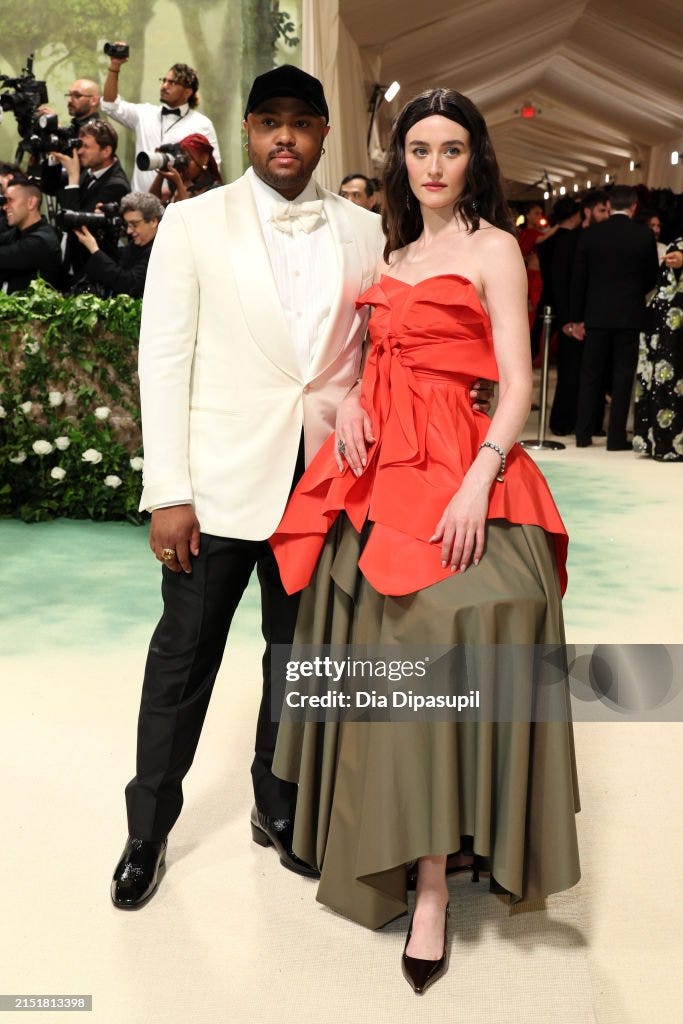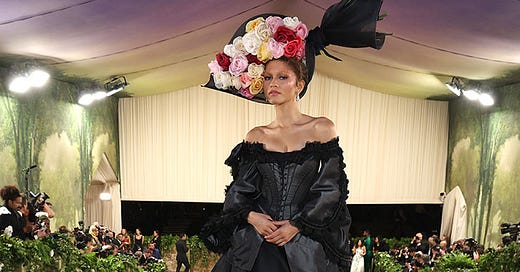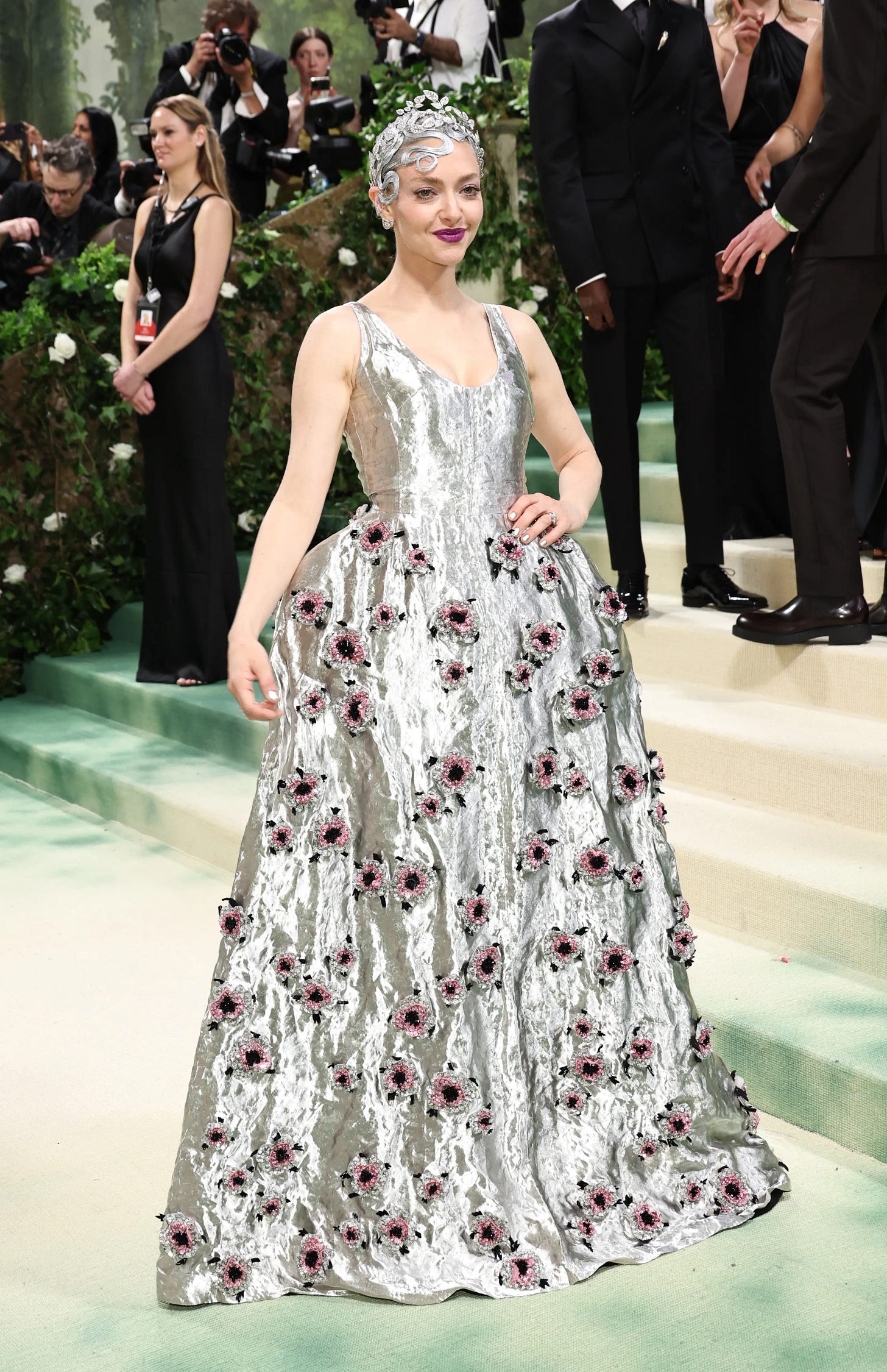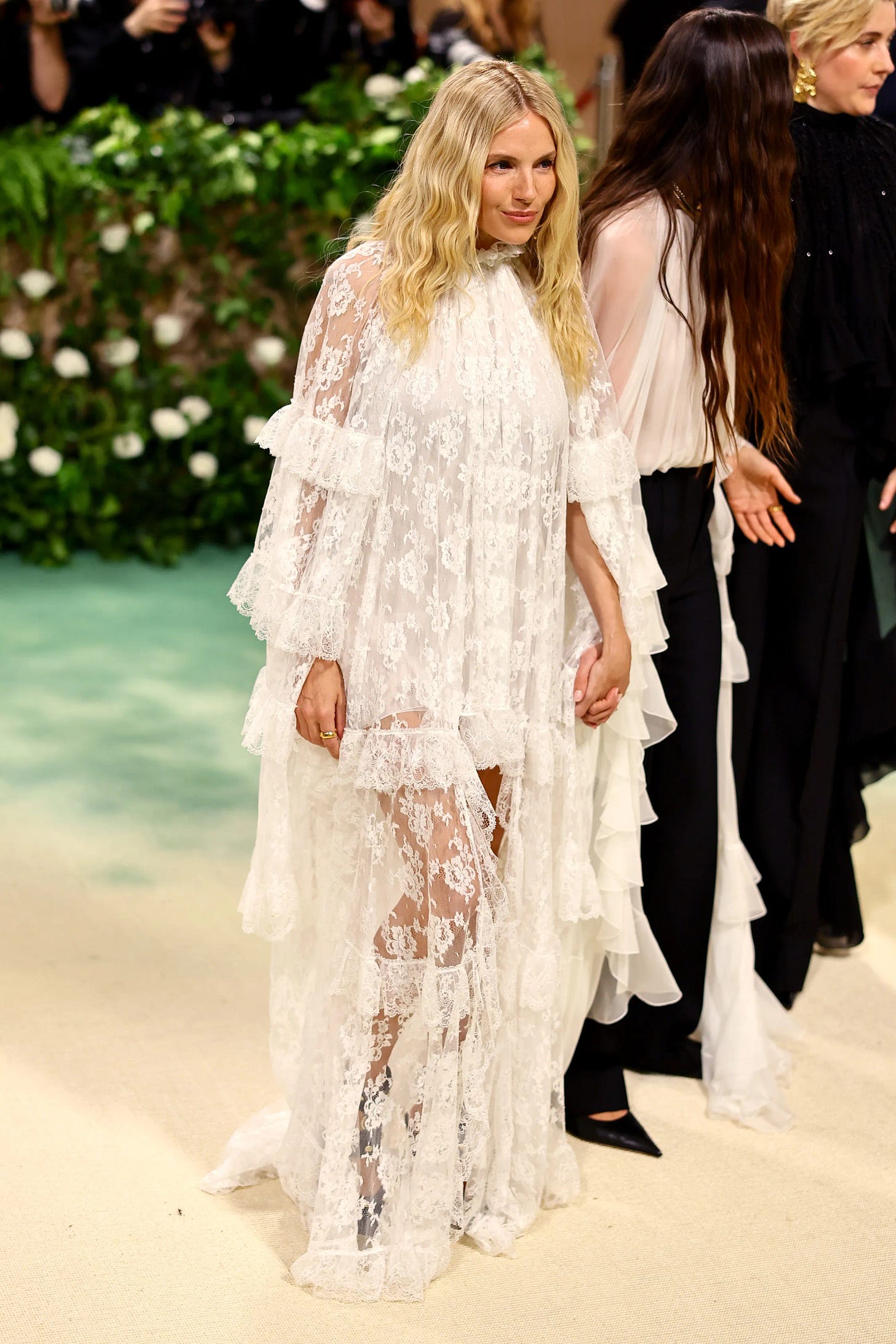The Met Gala is Fashion’s State of the Union
Observations, history and insight into fashion's biggest night

Preface: Sargent and Fashion
Yesterday, I visited Tate Britain’s current exhibition, Sargent and Fashion, which explored American painter John Sargent’s close relationship to fashion and the societal figures, often his friends he painted. Popular during the Victorian era, Sargent would act as both stylist and painter, commissioning costumes from local designers and draping fabrics over his painting subjects to achieve a certain look.
Hours later, I watched the 2024 Met Gala livestream on Vogue.com. I watched celebrities in corseted gowns, surrounded by stylists, feathers, and florals, wearing dewy makeup, and sharing how they were excited to go inside and see old friends. It reminded me of the Sargent exhibition in several ways: the relationship between muse and designer, the relationship between society and fantasy, and most significantly, the relationship between power, clothing, and influence.
To call the Met Gala the Party of the Year is to underestimate its power. With a ticket price of $75,000/attendee or $350,000/table and a renowned invite-only list, it is a curated list of the world’s most influential people, fashion brands, and designers.
Before I share my observations, below are a few FAQs and the history of the annual event:
What is the Met Gala?
The idea of the Costume Institute Benefit (also known as the Met Gala) was created by noted fashion publicist Eleanor Lambert, who also created The Battles of Versailles, the Council of Fashion Designers of America, and New York Fashion Week. The Met Gala is an annual fundraiser for the Metropolitan Museum of Art’s Costume Insititute, and according to the New York Times’s Vanessa Friedman, in 2023, the event raised $22M. The Costume Institute’s operating budget isn't covered by the Metropolitan Museum of Art because that was the deal when the museum acquired it in 1959.
Therefore, the Met Gala is the primary source of the Costume Institute’s annual funding. Friedman states that the Costume Insititute “makes so much [from Met Gala proceeds] that they give some back to the museum.” Met Gala co-chair since 1995, Anna Wintour (artistic director of Condé Nast and editor-in-chief of Vogue) is a museum trustee and has a museum wing, The Anna Wintour Costume Center, named after her.
Why is the Met Gala Important to Fashion Research?
The Costume Institute, with 33,000 fashion objects and accessories covering seven centuries, is the largest and most comprehensive costume collection in the world and includes the acquired collections of The Brooklyn Museum. It rotates costume exhibitions annually and frequently breaks museum records for the number of visitors. The institute includes a costume conservation facility, a study and storage facility, and “one of the world’s foremost fashion libraries.”
The Costume Institute’s permanent collection includes works by Black-American fashion designers Ann Lowe, Virgil Abloh, Denim Tears by Tremaine Ermory, Christopher John Rogers, and Telfar.

What is in a theme?
The Met Gala has seen a handful of co-chairs, but the two women most attributed with turning it from a New York City fundraiser to a global media event predicted to eclipse Cannes and the Oscars in coverage are Wintour and another editor-in-chief of Vogue, the famed Diana Vreeland. Known for her eccentric behavior and sense of style, as Gala co-chair throughout the ’70s and ’80s, Vreeland made the Met Gala more celebrity-oriented and introduced themed costume exhibitions.
Met Gala themes are controversial. It wasn't until the ‘00s that exhibition themes began to inspire attendees' looks, and since then, each year, we have seen a combination of literal and loose interpretations or overall dismissal of it.
This year’s costume exhibition is Sleeping Beauties: Reawakening Fashion, focusing on rare and fragile fashion in the museum’s archives that can never be worn on the human body again. The Gala dress code, however, was “The Garden of Time. “The Garden of Time” is a 1962 dystopian short story by J.G. Ballard. In it, a wealthy, refined couple tends to their magical garden, and their flowers temporarily delay time as an unruly working-class mob descends upon their home. As Gala attendees wear expensive haute couture, it's hard not to question industry veteran and Costume Institute curator Andrew Bolton’s dress code choice.
Key Trends: Sustainable Luxury Takes Sprout
eBay, along with Porsche, sponsored yesterday’s Met Gala. Combined with the ephemeral theme, it made sense, and it was refreshing to see sustainability featured on the red carpet compared to previous years. Vogue’s livestream host and actress, LaLa, got her jewelry from eBay. Singer Charli XCX wore a Marni gown made of 50 vintage t-shirts from the 1950s and 1960s, actress Amanda Seyfried wore a Prada gown made of leftover deadstock from their 2009 collection, and actress Demi Moore wore a gown by Harris Reed, created out of vintage archival wallpaper.
There is online debate about the number of archival looks worn yesterday, but nostalgia is eco-friendly and shows the power of thoughtful, conscious consumption. (I believe Kim Kardashian’s 2022 Met Gala look, where she wore Marilyn Monroe’s iconic ‘Happy Birthday’ dress, still gives everyone PTSD). Model Kendall Jenner wore vintage Alexander McQueen while he was creative director at Givenchy. The dress was shown on a mannequin during its initial presentation and had never been worn on a person in public. Gala co-chair, actress Zendaya’s second gown was a 1996 vintage Givenchy couture by John Galliano and reminded me of the Sargent painting Lady Sassoon (1907) and Beyoncé's 2018 American Vogue cover.
Even though archival fashion on the red carpet can get stuck on the same three designers - Galliano, McQueen, and Gianni Versace - yesterday offered a glimpse of the future and what could be red-carpet fashion’s next power move.
Industry Snapshot: Noticeable Absents and a Surprise Guest
Fashion is coded, and nothing is ever a coincidence, and last night was no exception.
Luxury conglomerate and Met Gala favorite Kering, who owns Gucci and is experiencing a market downturn (H1 operating profits forecasts -40-45% YoY), was noticeably absent. Meanwhile, “It” brands of the season, Loewe, owned by Kering rival LVMH; Thom Browne; and Chloe, who is still coming off their Fall/Winter 2024-25 runway high, dressed several emerging and influentially stylish attendees.
Tom Ford, the man, did not wear Tom Ford the brand and instead wore Yves Saint Laurent (YSL). This is eyebrow-raising because Ford was the first creative director after Saint Laurent at YSL, and Saint Laurent famously did not like Ford, stating that he “had no talent.” Peter Hawkings is the first creative director at Tom Ford after Tom Ford, so the parallel is damning.
However, the night's surprise guest was once-disgraced designer John Galliano, formerly at Givenchy and Christian Dior and now creative director of Maison Margiela. Although he wasn't in attendance, he dressed three of the most high-profile and arguably some of the best-dressed attendees, including gala co-chairs Zendaya and rapper Bad Bunny and Kim Kardashian.
In 2011, Galliano was ex-communicated from fashion after a series of videos showed him drunkenly shouting racist and anti-semitic remarks at innocent bystanders in a Parisian cafe. After being fired from Dior and fined by the French government, he entered rehab and had been under the radar until recently.
In March, his documentary High and Low: John Galliano (which I saw and think gives a balanced perspective) was released, following his critically acclaimed and viral Spring/Summer 2024 Maison Margiela runway show in January.
A tender moment in High and Low shows Anna Wintour and the late Vogue Editor-at-Large Andre Leon Talley looking for financial donors to support a struggling Galliano’s upcoming runway show. After last night, the murmurs that fashion and Wintour want to bring back Galliano publicly will only get louder.
Is it the right move? I’m unsure, especially given the current political climate and Galliano’s attempts for forgiveness. However, yesterday’s gestures reinforce that clothing is political and personal, and it does matter who you’re wearing.












Truly lovely piece! Thanks for this balanced, and informative essay. I learned so much! (About the history of the Met Gala and some juicy tidbits as well) impressive!